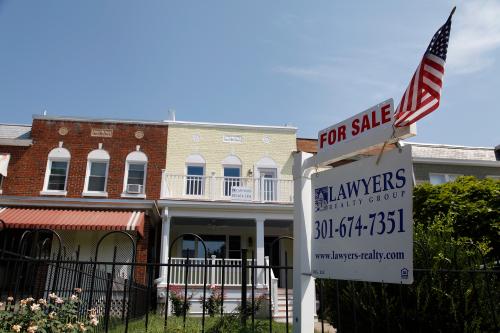Economic opportunity is not distributed equally across places. The COVID-19 pandemic and recent protests for racial justice have drawn attention to the stark gaps between Black and white communities in health, life expectancy, job quality, homeownership, and wealth, among many metrics of well-being. A growing body of evidence demonstrates that where children grow up profoundly impacts their lifetime outcomes.
For most of U.S. history, Black families faced explicit barriers to where they could live, including restrictive covenants, racial discrimination in mortgage lending, and “steering” by real estate agents. Such forms of overt discrimination are illegal today (although not entirely gone), replaced with more subtle barriers: especially zoning laws that block construction of apartments and other moderately-priced housing. Persistent disparities in income and wealth, combined with excessively strict zoning, limit Black households’ access to many high-opportunity communities. Put simply, high housing costs in exclusive neighborhoods are a major obstacle to racial integration and economic mobility.
Look for inequality within each metro
Much of the policy debate over housing affordability focuses on differences between metro areas. But housing costs vary just as much within metro areas as between them. Even in metro areas with moderately priced housing by national standards, some local jurisdictions are effectively priced out of reach to middle-income households—especially typical renter households.
I explore patterns of housing affordability across local jurisdictions (cities and counties) within four metropolitan areas: Dallas, Detroit, Los Angeles, and Washington DC. To identify exclusive localities in each metro, I compare local housing affordability—how expensive a community is for people who currently live in it—with regional affordability, whether a community is affordable for people who live in the broader metro area.
The analysis relies on rent-to-income ratios, a standard affordability metric. The U.S. Department of Housing and Urban Development recommends that households spend no more than 30% of their monthly income on housing costs, a rent-to-income ratio of 0.3. To measure local affordability, I divide the median rent in each jurisdiction by median household income in the same jurisdiction. Regional affordability is defined as median rent in the jurisdiction divided by median household income for the entire metro area.
In expensive metro areas, rent takes a larger share of monthly income
A core principle of urban economics is that workers are willing to move to expensive cities if they expect to earn higher wages or can enjoy place-specific amenities, such as good weather or cultural attractions. Graphing median monthly rent and rent-income ratios for the 100 largest metro areas suggests higher housing costs in some parts of the country are not fully offset by higher wages. Rent-to-income ratios generally increase as median rents rise, as shown by the upward sloping line in Figure 1.

The metros I focus on in this analysis are representative of three broad types of housing markets:
- Dallas TX is typical of “Expansive” metro areas that have experienced strong housing demand, driven by population and job growth, matched with rapid new housing construction. Housing costs in Dallas are moderate: the median rent of approximately $850 is slightly above the median among the 100 largest metros, and the rent-income ratio of 0.16 equals the median among these metros.
- The Detroit metro exemplifies “Legacy” metros, mostly in the Northeast and Midwest, that have seen slower population growth than the U.S. overall, thus less demand for additional housing. Detroit’s median rent ($725) and rent-income ratio fall in the lower quartile of large metros.
- The Los Angeles CA and Washington DC metro areas are typical of “Expensive” metros, characterized by strong population and job growth but limited new housing construction, due to overly restrictive land use regulations. Median rents in these metros ($1280 in LA and $1450 in Washington DC) are in the top 10% among the largest metros. LA’s rent-income ratio (0.23) is also in the top 10%, The Washington DC metro area is somewhat of an outlier among expensive metros, with a rent-income ratio (0.18) around the 75th percentile among large metros. Although housing supply is constrained in Los Angeles and Washington DC, the two metros exhibit very different patterns of local government. Los Angeles’ population is highly fragmented across more than 120 separate jurisdictions, while the Washington metro area is relatively consolidated, with four jurisdictions accounting for over 60 percent of the metro area population. As the following analysis shows, housing affordability patterns within these two metros varies considerably.
Every metro area has some affordable communities, and some not-so-affordable ones
Looking at median rent for an entire metro area obscures an important fact: rents vary as much or even more widely across jurisdictions within a metro area as between different metro areas. Figure 2 shows the distribution of rents for cities and counties that make up each of the four sample metros, noting the position of the primary central city (dark blue), one high-rent jurisdiction (orange) and one low-rent jurisdiction (light blue).1 Note that in all graphs throughout this analysis, the vertical and horizontal axes are not the same across metro areas.

Although the median rents vary across the four metros, the rent distributions overlap substantially. In Dallas, Los Angeles, and Washington D.C., rent in the primary city falls close to the median for the metro area, while the city of Detroit has somewhat lower rent than the metro area overall. Los Angeles has the widest range of rents among its constituent communities, ranging from just over $900 in the city of Commerce to $3500 in San Marino. Detroit has the lowest median rent and the smallest variance: half the jurisdictions have median monthly rents between $640 and $880.
While the upper range of rents varies widely across the four metros, there is less variation at the bottom: only five jurisdictions have median rents below $500. This corresponds to an implied “floor” created by the costs of operating and maintaining rental housing, including items such as mortgage payments, property taxes, insurance, and utilities.
High-rent communities are quite affordable—to people who already live there
Unsurprisingly, rent takes up a larger share of household income in high-rent metro areas. But the relationship is reversed when looking at local affordability in three of the four metro areas. Rent-to-income ratios are on average lower in high-rent jurisdictions in the Dallas, Detroit, and Los Angeles metros (Figure 3). Detroit has the steepest downward slope. Low-rent jurisdictions like the city of Detroit and Hamtramck have rent-income ratios around 0.25, while the affluent suburb of Bloomfield Hills, with median rent around $1700, has a rent-income ratio of 0.11. The same pattern is true in the Dallas metro: pricy suburbs like Highland Park have lower rent-income ratios than middle- and low-rent jurisdictions like Dallas and Garrett. The Los Angeles metro also has a negative relationship between rent-income ratios and rent, although with a flatter slope. These patterns reflect rising incomes for more affluent households, and income inequality more broadly. If you are rich, an expensive house is perfectly affordable.

The Washington D.C. metro has a slightly positive relationship between rent levels and local housing affordability. Households in more expensive jurisdictions, including the District of Columbia and Arlington, have to spend a larger share of their income to rent the median home than residents in less expensive suburban jurisdictions, like Rappahannock County VA. However, the positive correlation is relatively weak and statistically no different to zero. Unlike the other three metros, the population of the Washington D.C. metro is more concentrated in a few large counties; within these counties, there is substantial income sorting across high-rent and low-rent neighborhoods.
Middle- and low-income households cannot afford to live in exclusive communities
Local affordability doesn’t tell us the whole story: by definition, people currently living in expensive communities are able to afford housing in those places. Affordability is much worse for renter households, who typically earn less than homeowners (about 65% of median income). Regional affordability offers a more useful measure of accessibility: what share of income would typical households across the entire metro area have to spend to move into high-rent communities?
Comparing regional affordability to local affordability suggests a high degree of income sorting in three of the four metro areas: low- and high- income residents are living in quite different communities. Figure 4 shows regional affordability (vertical axis) compared to local affordability (horizontal axis) for the four metro areas. The 45-degree line denotes where local affordability and regional affordability are equal; jurisdictions above the line are more expensive for metro area residents than for the locality’s current residents. Locally affordable but regionally unaffordable jurisdictions are mostly expensive communities inhabited by wealthy residents, while low-rent jurisdictions with high concentrations of low-income residents fall below the 45-degree line (locally unaffordable but regionally affordable).

In all four metros, the expensive jurisdictions (orange) are above the 45-degree line, but the size of the gap between local and regional affordability varies widely by metro. The median rent in Highland Park and Bloomfield Hills is equivalent to around 35% of median income for the metro area, compared to 11% of median income for residents currently living in those communities. A typical household in the Los Angeles metro would need to spend 65% of their income to afford the median apartment in San Marino—more than twice HUD’s recommended threshold of 30%. Once again, the Washington D.C. metro is an outlier; the regional rent-to-income ratio Arlington is only slightly higher than local rent-to-income, with both ratios well below 0.3.
Rental affordability is particularly acute for Black and Latino households, a majority of whom rent their homes, and who have lower incomes than non-Hispanic whites, partly reflecting continued discrimination in labor markets. In effect, then, very high rents in exclusive communities serve as a barrier to racial integration: most Black and Latino households are priced out of these markets. In all four metro areas, high-rent jurisdictions have substantially smaller Black and Latino population shares than the metro area overall.

High rents block economic and racial integration
Whether or not expensive communities intend to bar entry to lower-income households, high housing costs are as prohibitive a barrier as more overt forms of discrimination. As long as there are substantial racial gaps in income and wealth, expensive communities will effectively be off limits to most Black and Latino households—as well as to renter households of all races. If the federal government intends to “affirmatively further fair housing”, one important step is to increase the availability of modestly priced housing in these high-rent communities. State governments that want to encourage “fair share” distribution of affordable housing should also pay attention to regional affordability.
This analysis also offers some insights into housing affordability measurements. When calculating metrics like rent-to-income ratios, the geographic areas chosen for both numerator and denominator matter a lot. Low-rent communities may appear to be unaffordable if they are home to many poor families, while expensive communities with exclusively affluent residents can mistakenly be seen as “affordable”. The regional affordability metric used in this analysis can help policymakers identify which local jurisdictions are priced out of reach of most residents—a necessary first step to fixing the problem.
Methodology note: For the Los Angeles metropolitan area, the analysis uses incorporated cities and towns. The Washington DC metro is composed of counties and independent cities in Virginia. For the Dallas and Detroit metros, the analysis uses a combination of cities, towns, and counties. For counties where more than 50% of population lives in unincorporated parts of county, I use median income & rent that corresponds to unincorporated county areas and drop incorporated cities.
The Brookings Institution is committed to quality, independence, and impact.
We are supported by a diverse array of funders. In line with our values and policies, each Brookings publication represents the sole views of its author(s).







Commentary
Exclusive communities deepen inequality in every metro area
July 16, 2020